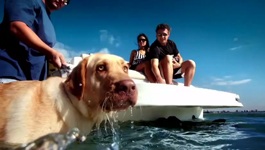Boating Lifestyle
Boating Lifestyle
There is so much to love, and learn, about boating. That's why we created this library of articles, videos and blog posts to help you throughout your adventures.
Saltwater Fishing Tactics: Overview
Before catching fish, anglers must locate them. Much of North America is within a day’s drive of the oceans, an estuary, or some other marine environment. You can find fish nearly anywhere there is food, oxygen, and cover. If you have a boat, your choice of angling locations gets even larger.
Where Fish May Be and Why
- Hiding areas, cover, structure, and the bottom
- Salinity
- Dissolved oxygen
- Water temperature
- Types and amounts of food
- Tides and currents
- Water depth
Structure
Salinity and Oxygen
Temperature
Food
The Benefits of Using a Boat
Choose the Methods that Suit You Best
- Knowing which angling approach to use, and when to use it, is critical to having a successful day on the water. Locate a good tackle shop and ask a lot of questions. Buy a good chart of the area and study it for cuts and channels, holes or humps, all the good places that might hold fish. Maybe even hire a guide. A day spent fishing with a guide is one of the best ways to improve your technique.
- Once you find the fish, getting them to bite your hook becomes the challenge. Each of the various types of fishing lends itself to catching certain kinds of fish. Surf fishing usually lands a good variety of species, without the need for an ocean-going boat. Most any healthy waterfront can offer good surf fishing, but pay particular attention to rocky beaches, rock jetties, and fishing piers. A typical surf fishing setup matches an 8 or 9 foot rod and reel with 14 to 20 pound test line, although longer rods make longer casts. For many anglers, however, pier fishing can be the best possible way to spend the best possible day. Some piers stand over or near reefs or underwater structures that shelter numerous residents and draw schools of migratory fish. Pier fishing is a relatively comfortable way to introduce children to marine angling as the piers attract many smaller fish for the kids as well as larger species for the adults. Many piers also have the amenities and facilities families enjoy.
Trolling: Effective and Enjoyable
- Either inshore or offshore, trailing lures or baits behind a slowly running boat enables anglers to cover a lot of water. Trolling is particularly effective for fish species that regularly feed on smaller fish. Outriggers (long extension spreaders) carry multiple lines out beyond the sides of the boat and enable trolling several lines at once. When a bait is struck, its line snaps free of the outrigger, to be played with a shorter, sturdy boat rod.
The Challenge of Fly Fishing
The Best Times to Fish
Picking the Best Season
Whenever you decide to go fishing, be sure that you have a licence and spend some time investigating the rules and regulations for the waters you’re planning to fish as well as the species in those waters. Each province has different regulations and you need to check to make sure that you are following those guidelines.
Here are links to the guidelines for each province.
British Columbia
Alberta
Saskatchewan
Manitoba
Ontario
Quebec
New Brunswick
Nova Scotia
Prince Edward Island
Newfoundland and Labrador
- Angler’s Guide (DFO)
Yukon
Northwest Territories
Nunavut
- To obtain a copy of the Nunavut Sport Fishing Guide, contact the Government of Nunavut Department of Sustainable Development headquarters office in Iqaluit (867) 975-5955 or the regional offices in Kugluktuk (867) 982-7240 or in Arviat (867) 857-2828.


